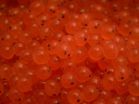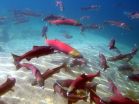(Press-News.org) Endangered Snake River sockeye salmon are regaining the fitness of their wild ancestors, with naturally spawned juvenile sockeye migrating to the ocean and returning as adults at a much higher rate than others released from hatcheries, according to a newly published analysis. The analysis indicates that the program to save the species has succeeded and is now shifting to rebuilding populations in the wild.
Biologists believe the increased return rate of sockeye spawned naturally by hatchery-produced parents is high enough for the species to eventually sustain itself in the wild again.
"This is a real American endangered species success story," said Will Stelle, Administrator of NOAA Fisheries' West Coast Region. "With only a handful of remaining fish, biologists brought the best genetic science to bear and the region lent its lasting support. Now there is real potential that this species will be self-sustaining again. The sockeye didn't give up hope and neither did we."
Biologists Paul Kline of the Idaho Department of Fish and Game and Thomas Flagg of NOAA Fisheries' Northwest Fisheries Science Center report the results in the November issue of Fisheries, the magazine of the American Fisheries Society.
These findings demonstrate that the program to save Snake River sockeye can indeed reverse the so-called "extinction vortex," where too few individuals remain for the species to sustain itself. Some thought that Snake River sockeye had entered that vortex in the 1990s, highlighted in 1992 when the sole returning male Redfish Lake sockeye, known as "Lonesome Larry" captured national attention.
NOAA Fisheries earlier this year released a proposed recovery plan for Snake River sockeye, which calls for an average of 1,000 naturally spawned sockeye returning to Redfish Lake each year, with similar targets for other lakes in Idaho's Sawtooth Valley. About 460 naturally spawned sockeye returned to Redfish Lake this year - the most since the program began - out of an overall record return of about 1,600.
The article in Fisheries recounts the 20-year history of the scientific program to save the Snake River sockeye. The program began with 16 remaining adult sockeye - 11 males and five females - taken into captivity from 1991 to 1998. Through advanced aquaculture techniques, the program has retained about 95 percent of the species' remaining genetic variability, while boosting surviving offspring about 2,000 percent beyond what could be expected in the wild.
Without such advances, the scientists write, "extinction would have been all but certain."
The program funded by the Bonneville Power Administration has released more than 3.8 million sockeye eggs and fish into lakes and streams in the Sawtooth Valley, and tracks the fish that return from the ocean. Hatchery fish returning as adults have also begun spawning again in Redfish Lake, increasingly producing naturally spawned offspring that are now also returning.
A new analysis of those returns shows that the naturally spawned sockeye are returning at rates up to three times higher than those released from hatcheries as smolts, and more than 10 times greater than those released as even younger pre-smolts.
The higher returns indicate the naturally spawned fish are regaining the fitness the species needs to better survive their 900-mile migration to the ocean, their years at sea, and the return trip to Redfish Lake. A salmon population must produce at least one returning offspring per adult to sustain itself.
Naturally spawned sockeye have returned at more than twice that rate in some years, indicating that under the right conditions they can not only sustain the species but add to it.
The results also suggest that hatchery-produced sockeye may regain the fitness advantages they need to sustain their species in the wild much faster than had been previously estimated, the scientists reported. Biologists caution that the current results span only three years so far, but indicate that fitness - and, in turn, survival - can improve in as little as only one generation in the wild.
"We hoped we could get returns equivalent to what you'd expect to see from a hatchery," said Flagg, manager of the NOAA Fisheries Northwest Fisheries' Science Center's Manchester Research Station. "We've seen the population respond even better than that, which bodes well for the idea that the lakes can produce the juveniles you'd want to see to get to recovery."
INFORMATION:
NOAA's mission is to understand and predict changes in the Earth's environment, from the depths of the ocean to the surface of the sun, and to conserve and manage our coastal and marine resources. Join us on Twitter, Facebook, Instagram and our other social media channels.
Available video: Redfish Lake & Eagle Hatchery B-Roll
Format: MP4 (H.264 codec) in HD 1080p 29.97
Description: 90-seconds of high-definition video and audio of Snake River Sockeye spawning at both the Eagle Fish Hatchery as well as in the wild in Redfish Lake near Stanley, Idaho. Includes underwater shots of sockeye. Following the b-roll are multiple excerpts of interviews with Christine Kozfkay, principal fisheries biologist, Idaho Department of Fish and Game, as well as Mike Peterson, senior fishery research biologist, with IDFG as well. Both work out of the Eagle Fish Hatchery in Boise, Idaho.
Download Link: http://bit.ly/1qsOfCY
MAYWOOD, Il. - An award-winning study by a Loyola University Chicago Stritch School of Medicine researcher has documented how homeless, mentally ill women in India face a vicious cycle:
During psychotic episodes, they wander away from home, sometimes for long distances, and wind up in homeless shelters. They then are returned to their families before undergoing sufficient psychosocial rehabilitation to deal with their illness. Consequently, they suffer mental illness relapses and wind up homeless again.
"The study illustrates how there must be a balance between reintegrating ...
While the turkey you eat on Thursday will bring your stomach happiness and could probably kick-start an afternoon nap, it may also save your life one day.
That's because the biological machinery needed to produce a potentially life-saving antibiotic is found in turkeys. Looks like there is one more reason to be grateful this Thanksgiving.
"Our research group is certainly thankful for turkeys," said BYU microbiologist Joel Griffitts, whose team is exploring how the turkey-born antibiotic comes to be. "The good bacteria we're studying has been keeping turkey farms healthy ...
How is it that vultures can live on a diet of carrion that would at least lead to severe food-poisoning, and more likely kill most other animals? This is the key question behind a recent collaboration between a team of international researchers from Denmark's Centre for GeoGenetics and Biological Institute at the University of Copenhagen, Aarhus University, the Technical University of Denmark, Copenhagen Zoo and the Smithsonian Institution in the USA. An "acidic" answer to this question is now published in the scientific journal Nature Communications.
When vultures eat ...
Who knew Blu-ray discs were so useful? Already one of the best ways to store high-definition movies and television shows because of their high-density data storage, Blu-ray discs also improve the performance of solar cells -- suggesting a second use for unwanted discs -- according to new research from Northwestern University.
An interdisciplinary research team has discovered that the pattern of information written on a Blu-ray disc -- and it doesn't matter if it's Jackie Chan's "Supercop" or the cartoon "Family Guy" -- works very well for improving light absorption across ...
New York, NY, November 25, 2014 - Testosterone (T) therapy is routinely used in men with hypogonadism, a condition in which diminished function of the gonads occurs. Although there is no evidence that T therapy increases the risk of prostate cancer (PCa), there are still concerns and a paucity of long-term data. In a new study in The Journal of Urology®, investigators examined three parallel, prospective, ongoing, cumulative registry studies of over 1,000 men. Their analysis showed that long-term T therapy in hypogonadal men is safe and does not increase the risk of ...
LAWRENCE -- Physicists at the University of Kansas have fabricated an innovative substance from two different atomic sheets that interlock much like Lego toy bricks. The researchers said the new material -- made of a layer of graphene and a layer of tungsten disulfide -- could be used in solar cells and flexible electronics. Their findings are published today by Nature Communications.
Hsin-Ying Chiu, assistant professor of physics and astronomy, and graduate student Matt Bellus fabricated the new material using "layer-by-layer assembly" as a versatile bottom-up nanofabrication ...
The bacterium Helicobacter pylori is strongly associated with gastric ulcers and cancer. To combat the infection, researchers at University of California, San Diego School of Medicine and Jacobs School of Engineering developed LipoLLA, a therapeutic nanoparticle that contains linolenic acid, a component in vegetable oils. In mice, LipoLLA was safe and more effective against H. pylori infection than standard antibiotic treatments.
The results are published online Nov. 24 in the Proceedings of the National Academy of Sciences.
"Current H. pylori treatments are facing ...
Medford/Somerville, Mass--Researchers in human genetics have known that long nucleotide repeats in DNA lead to instability of the genome and ultimately to human hereditary diseases such Freidreich's ataxia and Huntington's disease.
Scientists have believed that the lengthening of those repeats occur during DNA replication when cells divide or when the cellular DNA repair machinery gets activated. Recently, however, it became apparent that yet another process called transcription, which is copying the information from DNA into RNA, could also been involved.
A Tufts ...
Researchers at the University of Leeds have shed light on a gene mutation linked to autistic traits.
The team already knew that some people with autism were deficient in a gene called neurexin-II. To investigate whether the gene was associated with autism symptoms, the Leeds team studied mice with the same defect.
They found behavioural features that were similar to autism symptoms, including a lack of sociability or interest in other mice.
Dr Steven Clapcote, Lecturer in Pharmacology in the University's Faculty of Biological Sciences, who led the study published ...
Flexible electronics have been touted as the next generation in electronics in various areas, ranging from consumer electronics to bio-integrated medical devices. In spite of their merits, insufficient performance of organic materials arising from inherent material properties and processing limitations in scalability have posed big challenges to developing all-in-one flexible electronics systems in which display, processor, memory, and energy devices are integrated. The high temperature processes, essential for high performance electronic devices, have severely restricted ...





